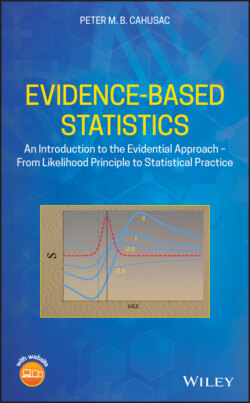Читать книгу Evidence-Based Statistics - Peter M. B. Cahusac - Страница 12
ОглавлениеIntroduction
Likelihood is the central concept in statistical inference. Not only does it lead to inferential techniques in its own right, but it is as fundamental to the repeated-sampling theories of estimation advanced by the ‘classical’ statistician as it is to the probabilistic reasoning advanced by the Bayesian.
Thus begins Edwards's remarkable book on Likelihood [1].
Fisher was responsible for much of the fundamental theory underlying the modern use of statistics. He developed methods of estimation and significance testing but also, according to Edwards [1, p. 3] ‘quietly and persistently espoused an alternative measure by which he claimed rival hypotheses could be weighed. He called it likelihood …’. Neyman and Pearson were drawn to the use of the likelihood ratio, stating ‘…there is little doubt that the criterion of likelihood is one which will assist the investigator in reaching his final judgement’ [2]. Eventually they turned away from using it, when they realized that it would not allow them to estimate the Type I error probability necessary for frequentist statistics. Edwards is not alone when he laments in his 1992 preface ‘Nevertheless, likelihood continues to be curiously neglected by mathematical statisticians’ [1].
Richard Dawkins (biologist and author) once said ‘Evidence is the only good reason to believe anything’. However, ‘evidence’ has become an over-used buzz word appropriated in expressions like ‘evidence-based education’. Overused and attached to statements on policy or practice, it is no doubt used with the intention of enhancing or validating their endeavours. Often ‘evidence-based’ statements appear to refer to statistics as providing the evidence. However, we are in the curious situation where the two most popular statistical approaches do not actually quantify evidence. Bayesian and frequentist statistics provide probabilities rather than any weight of evidence. The lesser known likelihood approach is alone in providing objective statistical evidence. All three approaches were developed in Britain (specifically England), yet only the likelihood approach provides admissible evidence in British courts of law.
Many excellent texts in applied statistics make mention of likelihood since it is a key concept in statistical inference. Despite this, few texts give practical examples to demonstrate its use. None are available at the introductory level to explain, step-by-step, how the likelihood ratio calculations for many different types of statistical analyses, such as comparisons of means, associations between variables, categorical data analyses, and nonparametric analyses, are done. The current text is an attempt to fill this gap. It is assumed that the reader has some basic knowledge of statistics, perhaps from an introductory university or school course. Otherwise, the reader can consult any one of a large number of excellent texts and online resources.
John Tukey, a mathematician who made huge contributions to statistical methodology, once said: ‘Far better an approximate answer to the right question, which is often vague, than an exact answer to the wrong question, which can always be made precise’ [3]. A p value provides an exact answer, but often to the wrong question.
For historical reasons, likelihoods and their ratios will probably not replace analyses using other approaches, especially the well-entrenched p value. However, the likelihood approach can supplement or complement other approaches. For some, it will add another instrument to their statistical bag of tricks.
References
1 1 Edwards AWF. Likelihood. Baltimore: John Hopkins University Press; 1992.
2 2 Neyman J, Pearson ES. On the use and interpretation of certain test criteria for purposes of statistical inference: part I. Biometrika. 1928; 20A(1/2):175–240.
3 3 Tukey JW. The future of data analysis. The Annals of Mathematical Statistics. 1962; 33(1):1–67.
